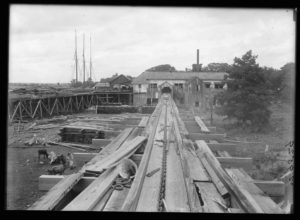Huron Smith in Georgia
- Location: McIntosh County, Georgia
- Directors: Stephen Berry (History) and Brian Drake (History)
- Schedule: Fall 2019-Spring 2021
Almost forgotten today, Huron Smith was once the most promising dendrologist and ethnobotanist in the United States. Assistant Curator of Botany at the  Field Museum in Chicago, he became head of botany at the Milwaukee Public Museum. Smith spent much of his time documenting the herbal and agricultural practices of the Winnebago, Menomini, Potawatomi, and Ojibwe. His respect for native cultures was profound, and he was obsessed by the idea that human knowledge was being lost as federal policy, especially the Dawes Act, drove the native population to its lowest ebb.
Field Museum in Chicago, he became head of botany at the Milwaukee Public Museum. Smith spent much of his time documenting the herbal and agricultural practices of the Winnebago, Menomini, Potawatomi, and Ojibwe. His respect for native cultures was profound, and he was obsessed by the idea that human knowledge was being lost as federal policy, especially the Dawes Act, drove the native population to its lowest ebb.
More obscure even than Smith’s work with native peoples was his extended sojourn in Georgia, 1908-1910. Smith had come south to see what Georgia’s timber trade was doing to the coastal interior. By 1900 Darien had become the international hub of the lumber business; Georgia pine sat at the heart of the U.S.S. Constitution and the Brooklyn Bridge. The industry told itself and its clients that Georgia’s forests were inexhaustible. Smith knew different. He took hundreds of photographs in Georgia: massive flotillas of old-growth pines, lashed together and floated down the Altamaha, drifting into Darien to arrive at sawmills running at full steam. These images he juxtaposed with photographs of splendid, still-living trees: “The Tree That Owns Itself” in Athens, Georgia; the John Wesley tree on St. Simons Island, sign slung around it reading, “Do not mutilate or cut.”
Six years after Smith’s sojourn, Georgia’s timber industry collapsed. From 100 million linear board feet per year at its height, output stalled and then died. An era was over, and the last of the giant saw millers, Hilton and Dodge, shuttered its doors in 1916. Huron Smith was preoccupied by vanishing things: the Indians of the Midwest, the old-growth pine forests of the South. His botanical writing and collecting came from a place of urgency and appreciation, driven always by a sense that we are running out of time.
The Huron Smith in Georgia project will involve a series of senior thesis courses (in 2020 and 2021) in which students pursue projects focused on the environmental history of the Georgia coast while also working with community partners in Darien to create a curated digital archive of the photographs of Huron Smith in Georgia. These courses will culminate in an excursion down the Altamaha, following the lumber trade while learning in the field about the current ecological state of the Altamaha basin. Concluding in Darien, the project will host a photography exhibit / community workshop featuring presentations of student research along with talks by leading environmental scholars.
